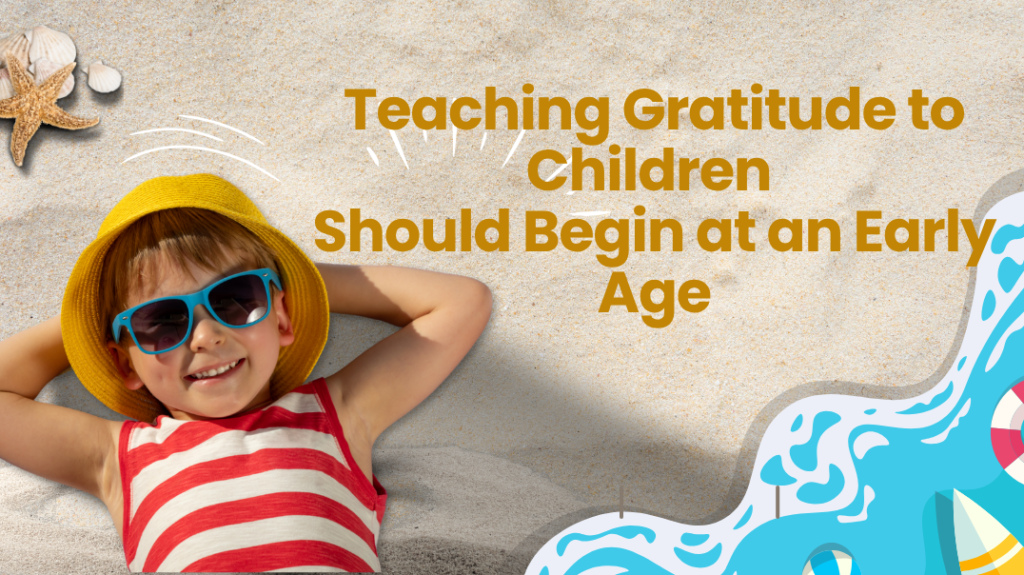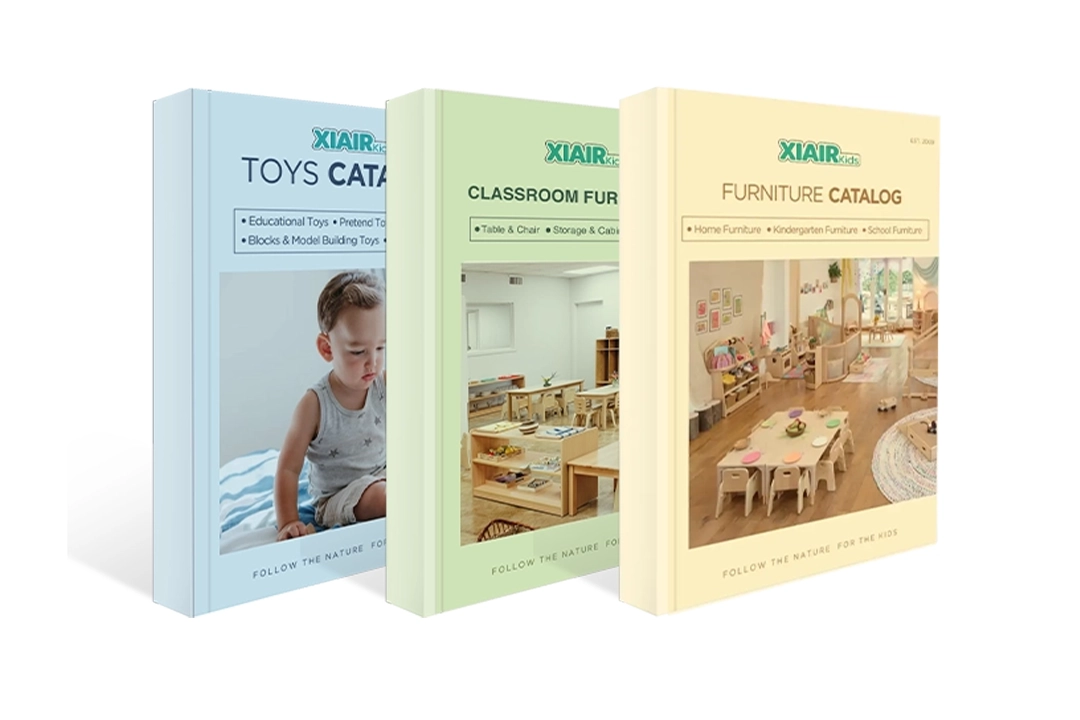Why is teaching gratitude to children so important today? What changes when we start teaching gratitude to children at an early age? Can it truly impact their long-term behavior and happiness? How can educators and parents work together to make teaching gratitude to children part of daily life?
Yes, teaching gratitude to children from an early age fosters emotional growth, empathy, and resilience. It helps them form stronger social connections, reduces entitlement, and builds a positive mindset. Gratitude shapes how children interact with others and view the world, laying the foundation for better relationships and overall well-being.
Teaching gratitude to children creates a lasting impact on their character and emotional well-being. When gratitude becomes part of daily routines, children grow up more mindful, respectful, and connected to those around them. It sets the tone for a more compassionate and emotionally intelligent generation.
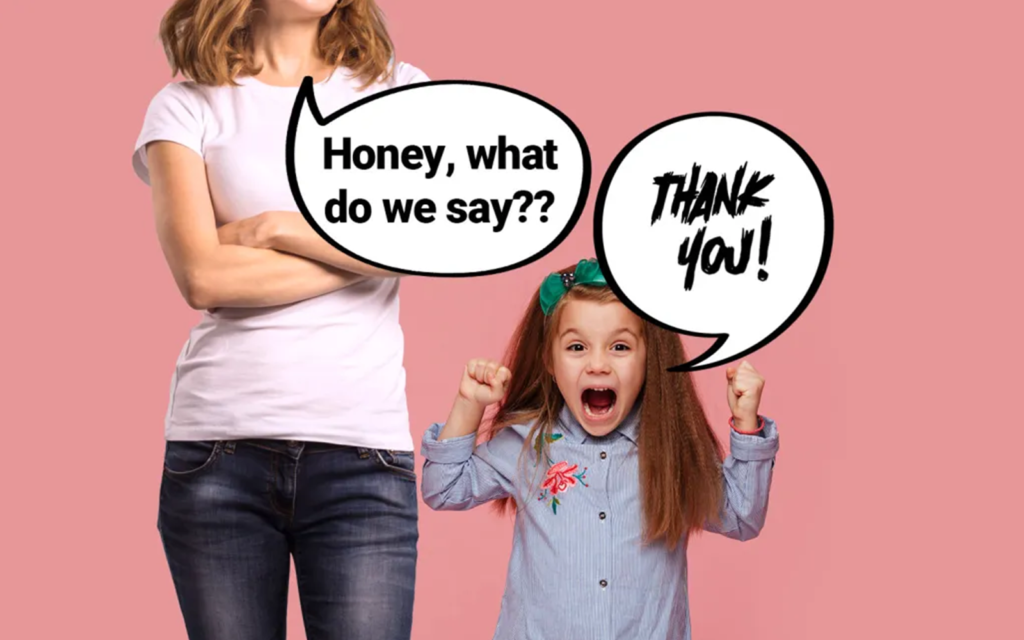
“A grateful heart is a beginning of greatness. It is an expression of humility. It is a foundation for the development of such virtues as prayer, faith, courage, contentment, happiness, love, and well-being.” – James E. Faust
What is Children’s Gratitude?
Gratitude is more than a polite “thank you.” Especially in children, gratitude is a reflection of emotional development, empathy, and an understanding of connection. But what is children’s gratitude? It’s not just about being well-mannered—it’s about how a child learns to appreciate others, recognize kindness, and respond with sincerity.
Children’s gratitude is a developing emotional response that begins to form when they realize that others make efforts to help them. It may start with a simple verbal cue, like thanking a parent for a meal or a friend for sharing a toy. But over time, this gratitude deepens into something more meaningful: a feeling of appreciation for relationships, experiences, and support. That’s why teaching gratitude to children is not about enforcing rules—it’s about guiding them to understand and feel grateful from the heart.
Young children don’t automatically know how to be grateful. Gratitude, like empathy and kindness, must be taught. This teaching begins with modeling. When adults consistently express thanks, acknowledge effort, and appreciate small things, children begin to internalize these behaviors. If they see a parent thank a teacher or a caregiver thank a child, they start to understand that appreciation is an essential part of everyday relationships.
لا تحلم فقط، بل صممه! دعنا نتحدث عن احتياجاتك من الأثاث المخصص!
Another important aspect of teaching gratitude to children is helping them understand context. For example, when a child receives a gift, it helps to explain where the gift came from and why it matters. “Grandma picked this out just for you because she knew it would make you happy.” This builds emotional awareness. It shifts the moment from simply receiving something to valuing the thought and effort behind it.
Gratitude in children also shows up in how they treat others. A grateful child is often more generous, more empathetic, and more emotionally aware. These qualities don’t appear overnight—they result from consistent conversations, intentional practices, and environments where appreciation is noticed and encouraged. Educators, especially in Montessori and Reggio-inspired classrooms, often build gratitude into daily routines through reflection activities, thank-you songs, or classroom roles that emphasize helping others.
There are also developmental stages to consider. Toddlers may mimic gratitude words without fully understanding them, while preschoolers begin to grasp the concept of thankfulness in response to specific actions. By the time children reach school age, they can reflect on broader ideas: being thankful for friendship, safety, or learning opportunities. This emotional growth can be supported by journaling, storytelling, or regular gratitude conversations at home and school.

Why is children’s Gratitude important?
Gratitude isn’t just good manners—it’s the foundation of a healthy emotional life. In today’s fast-paced, screen-dominated world, teaching gratitude to children has become more critical than ever. But why does gratitude matter so much, especially in childhood?
Let’s explore the profound benefits of helping children grow up grateful and how teaching gratitude to children supports their emotional, social, and mental development from the very beginning.
Gratitude Builds Emotional Intelligence in Children
Children who are consistently taught to be grateful become more emotionally aware and resilient. Gratitude helps them identify positive emotions, which in turn promotes self-regulation and empathy.
Teaching gratitude to children encourages them to recognize the good in others and express appreciation, an essential emotional skill in both friendships and family life. Research shows that grateful children report higher levels of happiness, lower stress, and stronger social bonds.
([source link placeholder]).
When children learn to say “thank you” and mean it, they begin to internalize empathy. They notice kindness, reflect on it, and understand that others’ actions matter. Gratitude becomes a lens through which they interpret the world, more positively and less entitled.
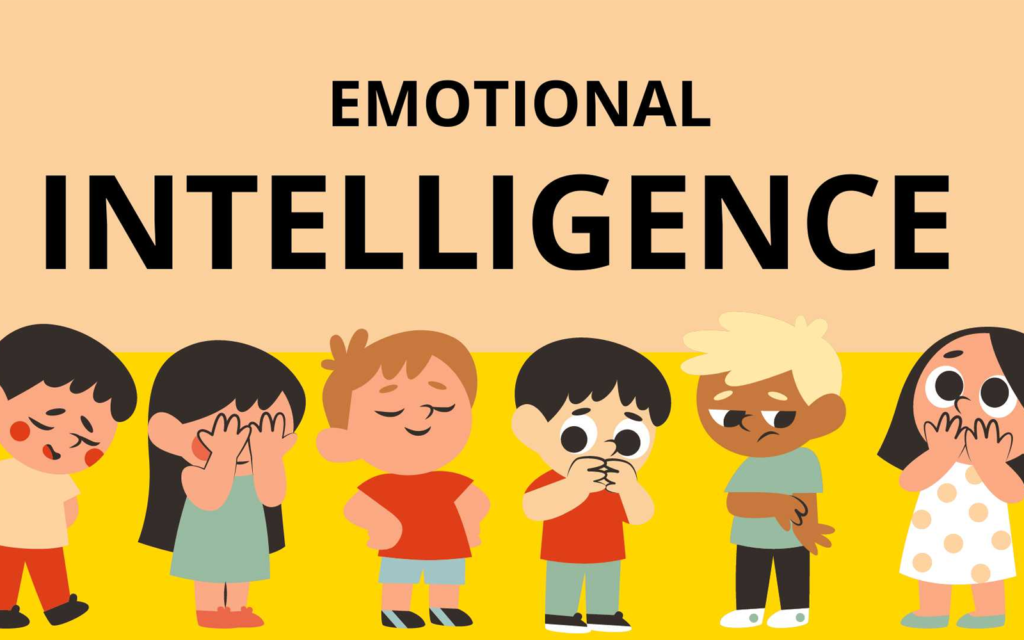
Gratitude Strengthens Social Relationships
Social development is a huge part of early childhood education. Teaching gratitude to children allows them to build stronger and more meaningful connections. Children who practice gratitude are more likely to be kind, cooperative, and generous with their peers. They’re also better at conflict resolution, as they’re more tuned in to the feelings of others.
In group learning environments, like Montessori or Reggio Emilia classrooms, gratitude fosters community. Saying “thank you” after sharing, helping, or playing together isn’t just about politeness—it’s about building social trust and mutual respect.
When gratitude becomes a shared classroom value, children thrive emotionally and socially. They feel more accepted and are more likely to accept others in return.
فصلك الدراسي المثالي على بعد نقرة واحدة!
Gratitude Enhances Mental Well-being and Reduces Entitlement
One of the most significant long-term benefits of teaching gratitude to children is the reduction of entitlement. A grateful child is less focused on what they lack and more concentrated on what they already have. This mindset shift leads to lower levels of anxiety, depression, and dissatisfaction.
Gratitude also teaches mindfulness. When children pause to think about what they’re thankful for—whether it’s their family, a toy, or a sunny day—they engage in present-focused thinking. This helps regulate negative emotions and builds a more optimistic view of life.
As children grow, this habit of gratitude becomes a mental health asset. It supports positive self-image and reduces comparison with others, especially critical in the teenage years.
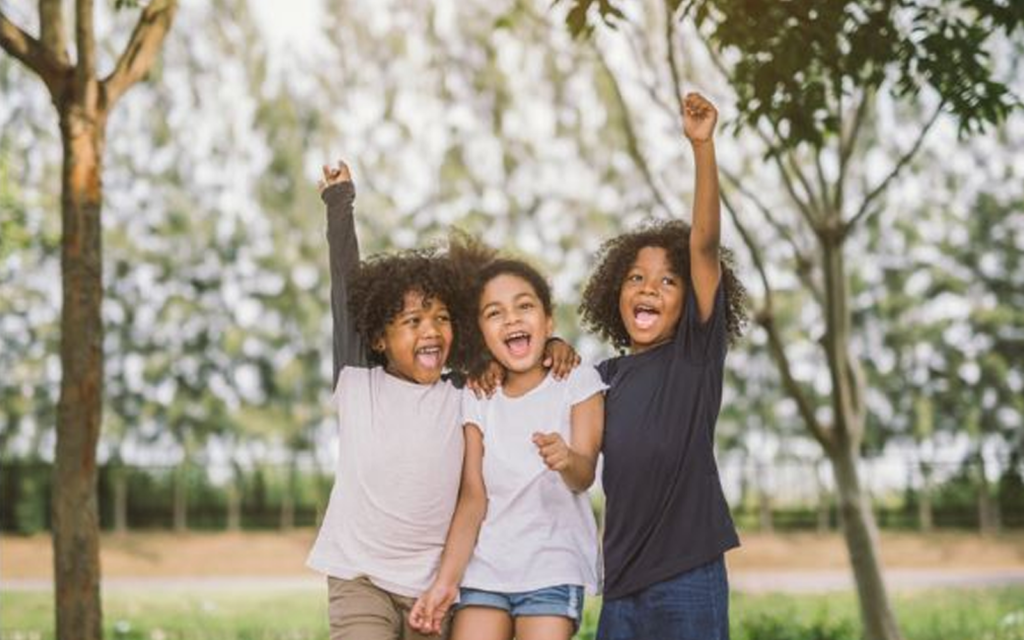
The Role of Adults in Teaching Gratitude to Children
Gratitude doesn’t appear overnight. It needs to be modeled, practiced, and repeated. Parents, teachers, and caregivers play a crucial role in teaching gratitude to children by modeling thankful behavior, encouraging daily gratitude rituals, and acknowledging moments of kindness.
Storytelling, journaling, or simple daily reflections can make gratitude part of a child’s natural routine. Even young children can begin with “thank you” circles, where each child says something they appreciated that day.
By making gratitude part of the emotional curriculum, we’re not just raising well-mannered kids—we’re nurturing emotionally intelligent future adults.
فصلك الدراسي المثالي على بعد نقرة واحدة!
10 Tips for Teaching Gratitude to Children
Teaching Gratitude to Children isn’t something that happens overnight—it’s a habit, a mindset, and a life skill that must be cultivated over time. While many adults focus on discipline and academic growth, gratitude is often overlooked in early childhood education. However, gratitude has long-term effects on a child’s emotional intelligence, relationships, and mental well-being. Below are ten thoughtful and actionable tips to help you start teaching gratitude to children in ways that feel natural, meaningful, and lasting.
Set an Example
Children learn far more from what we do than from what we say. If we want them to be thankful, we must demonstrate gratitude ourselves. This means saying “thank you” sincerely and often—not just to the child, but to others in their presence. Let them see you thank the store clerk, a teacher, or even a family member. More importantly, go beyond the words. Express appreciation for experiences, nature, acts of kindness, and life’s small moments. When children observe adults practicing gratitude regularly, they begin to understand its value and are more likely to mirror this behavior in their own lives.
Point Out Generosity
Children often receive things—gifts, help, kindness—without understanding the effort behind them. One way to reinforce gratitude is to point out acts of generosity. When a teacher helps them, a friend shares a snack, or a grandparent gives a present, pause and explain that someone made an effort just for them. “Wasn’t it thoughtful of your friend to include you in their game?” or “Grandma spent time making that for you—how kind!” These moments create awareness and help shift a child’s focus from receiving to appreciating.
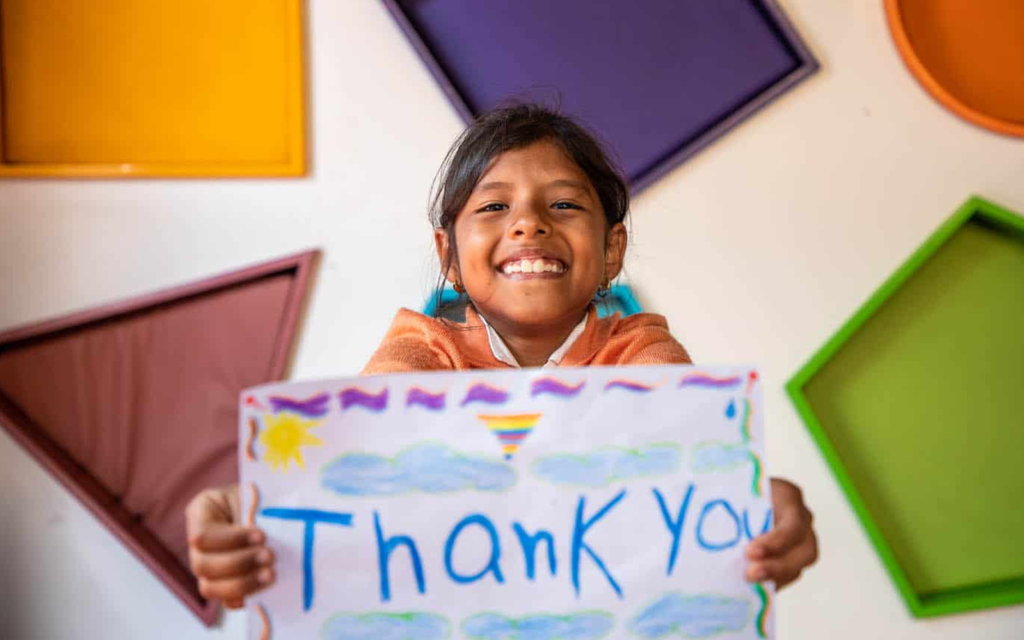
Have a Talk
Don’t assume children always understand gratitude simply because they say “thank you.” Schedule short, age-appropriate conversations about what it means to be grateful. Ask open-ended questions like, “What’s something someone did today that made you happy?” or “What are three things you’re thankful for today?” These discussions help children process their emotions and experiences through the lens of appreciation. They also provide a chance for parents or educators to reinforce values gently, turning gratitude from a reaction into a conscious choice.
Find Fun Ways to Say Thanks
Teaching gratitude to children can be both fun and creative. Kids respond better when learning is playful. Encourage them to draw thank-you cards, create a “thankful” collage from magazines, or even come up with their gratitude songs or dances. These playful methods deepen their understanding and make gratitude a joyful part of their daily lives rather than a chore. When children associate gratitude with creativity and fun, they are more likely to embrace it wholeheartedly.
Put Things in Perspective
It’s easy for children—especially in affluent environments—to assume that everything they receive is normal or guaranteed. One effective way to teach gratitude is by helping them see beyond their immediate experiences. This doesn’t mean guilt-tripping them, but gently offering context: “Some kids don’t have warm jackets like yours,” or “We’re lucky to have food on the table every day.” You can also use stories, books, or age-appropriate documentaries that expose them to different lifestyles and help them understand how fortunate they are. This perspective cultivates empathy and deepens gratitude.

Get Involved
Community service is a powerful way to make gratitude real for children. When they participate in activities like donating toys, visiting the elderly, or helping neighbors, they experience both giving and receiving kindness. Even small acts, like cleaning up after a family meal or helping a sibling, can be framed as opportunities to give back. These acts allow children to appreciate effort, time, and compassion, both in what they offer and what others provide. Volunteering together as a family or classroom builds gratitude into the fabric of daily life.
Make Gratitude Part of Bedtime
Routines shape childhood, and bedtime is a perfect moment for reflection. Create a simple nighttime gratitude ritual. This could be as easy as asking, “What’s one good thing that happened today?” or letting the child share a “thank you” moment from their day. Over time, this nightly practice becomes a habit. It trains their brain to look for the positive, even on tough days. These bedtime reflections also offer comfort and emotional closeness, reinforcing gratitude as a source of peace and connection.
Give kids credit
One of the most overlooked aspects of teaching gratitude to children is recognizing when they show it. Many adults expect children to be grateful, but forget to reinforce it when it happens. Positive reinforcement is key. When a child says “thank you” without prompting, acknowledges someone’s help, or shows appreciation in their way, take a moment to recognize it.
Say things like, “I noticed how you thanked your friend today—that was kind,” or “You were very thoughtful when you helped clean up without being asked.” These affirmations not only encourage the behavior to continue but also make the child feel seen and valued. Acknowledging their efforts helps children build internal motivation. They begin to associate gratitude with positive identity—something that makes them feel proud, mature, and respected.

When Do Children Learn About Gratitude?
Gratitude is one of the most valuable emotional skills we can teach children. But many parents and educators wonder: When do children actually start to understand gratitude? And more importantly, how can we support that development in meaningful, age-appropriate ways?
Understanding the stages of emotional and cognitive growth is key to teaching gratitude to children effectively. Gratitude doesn’t appear overnight—it evolves slowly and steadily, depending on the child’s age, environment, and the guidance they receive.
The Early Years: Imitation Without Understanding (Ages 1–2)
At around one year old, children begin to mimic adult behavior. If they hear “thank you” often, they may try to repeat it. But at this stage, the response is primarily mechanical. They may say the words without understanding their meaning.
Role of Adults at This Stage
Even if toddlers don’t fully grasp gratitude, this is a great time to model it consistently. Say “thank you” when they hand you something or when someone does something kind. By hearing and observing gratitude in action, toddlers begin to associate it with kindness and social connection.
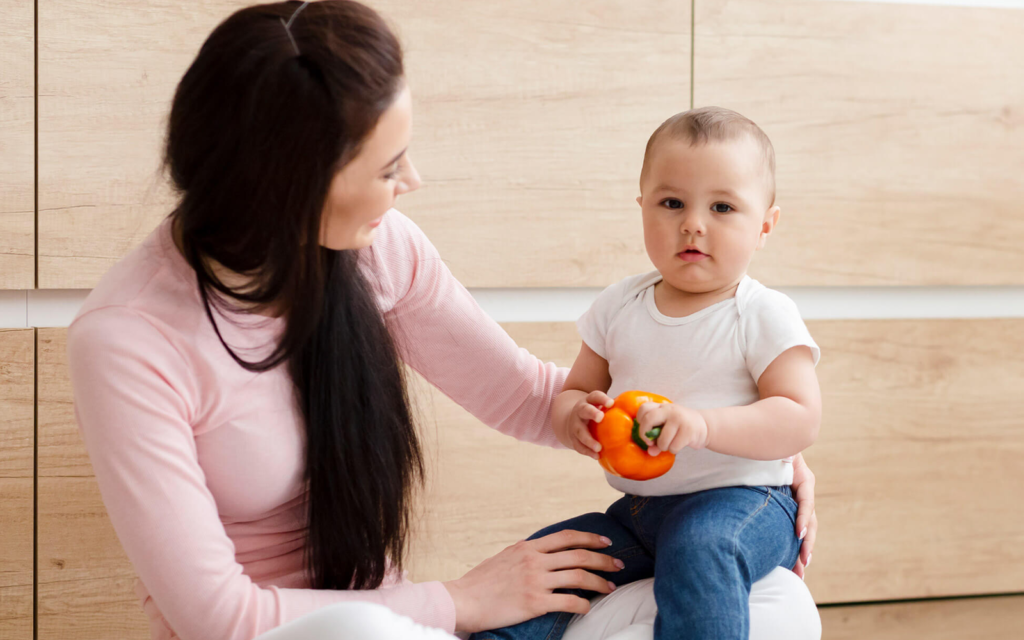
Early Understanding Begins (Ages 3–4)
By the age of 3, children begin to understand basic emotions—happiness, sadness, kindness—and this is when the seeds of gratitude are first planted. They start to notice when someone gives them something or helps them, and they can learn to respond with thanks.
Teaching Gratitude to Children Ages 3–4
This is an ideal time to begin teaching gratitude to children through storytelling, simple reflection questions, and praise. Books that highlight gratitude, like Bear Says Thanks or The Thankful Book, are practical tools. You can also ask, “What are you thankful for today?” or encourage them to make thank-you cards.
At this stage, it’s essential to reinforce the emotion behind gratitude, not just the word. Help them understand why they are thankful, not just how to say it.
فصلك الدراسي المثالي على بعد نقرة واحدة!
Growing Empathy and Thoughtfulness (Ages 5–6)
By age 5 or 6, most children can recognize the feelings and efforts of others. They start understanding that someone chose to help or give them something, and this is when gratitude takes on a deeper meaning.
Making Gratitude More Reflective
Children at this stage benefit from teaching gratitude practices that involve empathy and perspective-taking. For example:
- “How do you think your friend felt when you said thank you?”
- “Why do you think Grandma brought you that gift?”
These types of questions help children connect gratitude with emotion, kindness, and social awareness.

Ages 7 and Beyond: Gratitude as a Habit
From age seven and up, children develop more complex emotional awareness. They are better able to reflect on past actions and future consequences. Gratitude becomes more thoughtful and less prompted. They may start to write in journals, express appreciation for non-material things, or notice efforts made by others without reminders.
Building a Lifelong Skill
Teaching gratitude to children at this stage should involve ongoing reflection, discussion, and modeling. Ask more in-depth questions like:
- “What’s something someone did for you this week that made you feel thankful?”
- “What do you appreciate that you didn’t have last year?”
By encouraging regular expression and recognition of gratitude, you help children form a lifelong emotional habit—one that leads to better relationships, stronger mental health, and a more positive outlook on life.
Teaching Gratitude to Children the Montessori Way in Preschool Environments
Gratitude is not just a polite gesture—it’s a mindset. In early childhood education, especially in Montessori preschool settings, teaching gratitude to children is viewed as a vital part of character formation and emotional intelligence. Unlike traditional schooling, Montessori environments create daily opportunities for children to practice appreciation through independence, respect, and reflection.
Gratitude as Part of Practical Life
في فصول مونتيسوري, Practical Life activities are designed to promote independence and care for the environment and others. Children learn to set the table, serve food, and clean up after themselves, not just for self-sufficiency, but to contribute to the community. When a child pours water for a friend or helps a classmate zip a jacket, they experience both giving and receiving. Teachers model gratitude by acknowledging these small, intentional acts: “Thank you for helping your friend,” or “That was very thoughtful of you.”
By connecting practical actions with social meaning, Montessori educators make teaching gratitude to children a lived experience rather than a lecture.
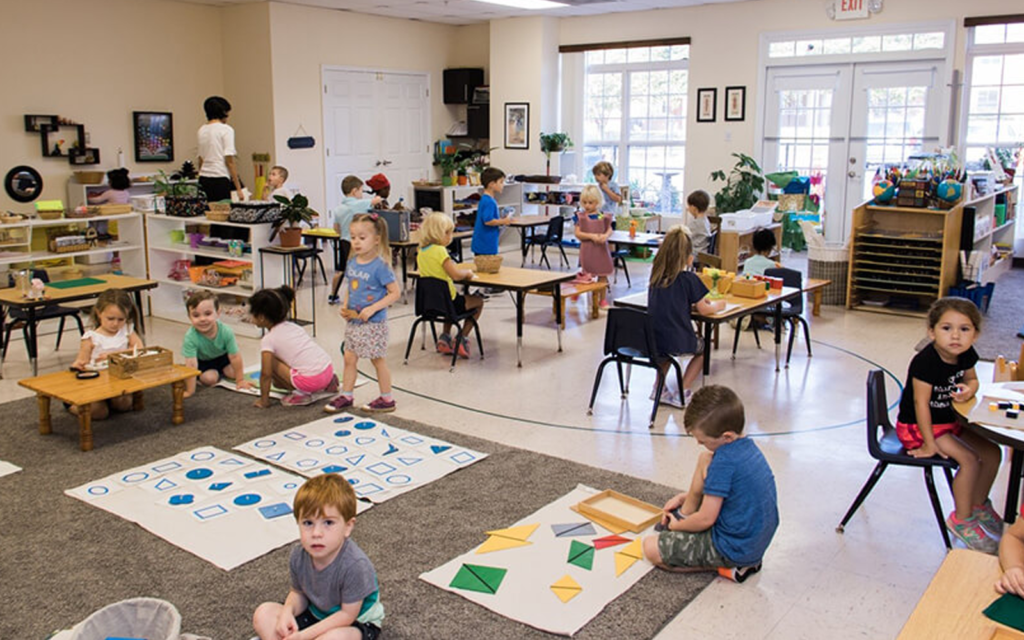
Grace and Courtesy as a Gratitude Foundation
Montessori education emphasizes Grace and Courtesy lessons, where children practice social behaviors like saying “please,” “thank you,” offering help, and showing respect. These lessons are often role-played in small groups, allowing preschoolers to explore the emotional impact of kind words and considerate actions.
Children learn that gratitude is not just expected—it’s meaningful. When a teacher says, “We thank our materials when we return them,” it instills a quiet sense of respect for both people and objects. Gratitude becomes part of a child’s daily rhythm, woven into every interaction in the classroom.
Reflection Time Encourages Deeper Gratitude
فصول مونتيسوري also provide children with moments of calm and reflection. Whether it’s through silent games, nature observation, or journaling (for older preschoolers), children are encouraged to pause and think. These reflective habits nurture inner awareness, allowing children to recognize positive experiences and name what they are thankful for.
For example, a simple circle time activity might include asking each child to share one thing they appreciated about the day. This gentle practice strengthens emotional vocabulary and helps internalize gratitude as a feeling, not just a phrase.
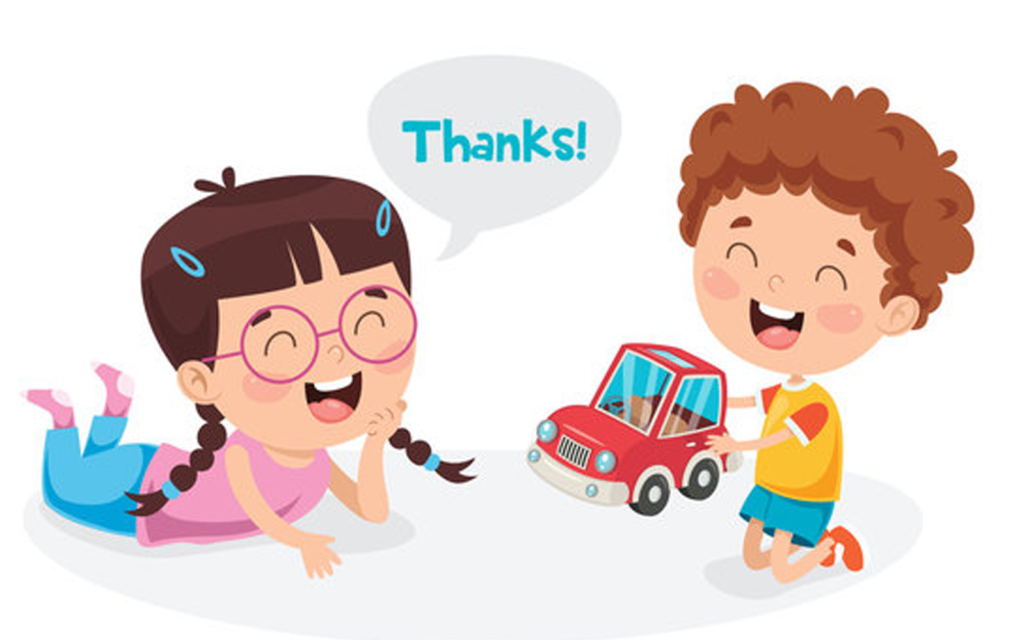
Gratitude vs Thankful
| وجه | Gratitude | Thankful |
|---|---|---|
| Definition | A deeper, ongoing emotional state that involves appreciation and recognition of kindness, support, or value received. | A momentary feeling of being pleased or relieved by a specific outcome or event. |
| Emotional Depth | Deep and reflective. Involves awareness of others’ intentions and efforts. | It can be taught earlier through basic social habits. |
| مدة | Long-lasting mindset or perspective. | Temporary or situational feeling. |
| ركز | Focused on others and the meaning behind their actions. | Focused on the result or benefit received. |
| مثال | “I feel gratitude for my teacher who helped me grow all year.” | “I’m thankful I passed the test.” |
| Development in Children | Requires emotional maturity and guidance. Cultivated over time. | Introduced early as a basic social skill (e.g., saying “thank you”). |
| Connection to Kindness | Strong link to recognizing and reciprocating kindness. | Less likely to involve reciprocal action or deep emotional response. |
| Relation to Values | Part of a character-building and value-based education approach. | Often part of good manners or emotional etiquette. |
| Teaching Application | Emphasized in long-term social-emotional learning programs. | Introduced early as basic social skill (e.g., saying “thank you”). |
فصلك الدراسي المثالي على بعد نقرة واحدة!
Gratitude Activities for Kids That Build Kindness and Emotional Awareness
Gratitude is a powerful tool in shaping a child’s emotional development and interpersonal skills. When children learn to appreciate others, notice small acts of kindness, and express thankfulness, they build empathy, resilience, and emotional intelligence. These gratitude activities for kids are designed not just to teach politeness but to help young learners deeply understand the value of kindness and the emotions that come with it.
Gratitude Drawing Time
Ask children to draw a picture of something or someone they’re thankful for. This could be their family, a friend who helped them, their favorite food, or even a toy. After drawing, give them time to talk about what they drew and why it matters to them. This activity helps children translate feelings into visual language and encourages reflective thinking about what brings joy or comfort to their lives.
Gratitude Jar
Create a “Gratitude Jar” where kids can write or draw small acts of kindness they observe or experience each day. It could be as simple as “Mom helped me tie my shoes” or “I shared my crayons with a friend.” At the end of the week, read the entries together. This helps children pay attention to others’ actions and recognize the role of kindness in daily life.
فصلك الدراسي المثالي على بعد نقرة واحدة!
Thank You Card Crafts
Provide children with paper, stickers, stamps, and colored pencils to create thank-you cards. These can be for anyone—teachers, parents, grandparents, or even a friend. The process of thinking about someone to thank and putting effort into expressing that thanks helps children understand appreciation beyond words. You can also encourage verbal delivery of the cards to build social courage and sincerity.
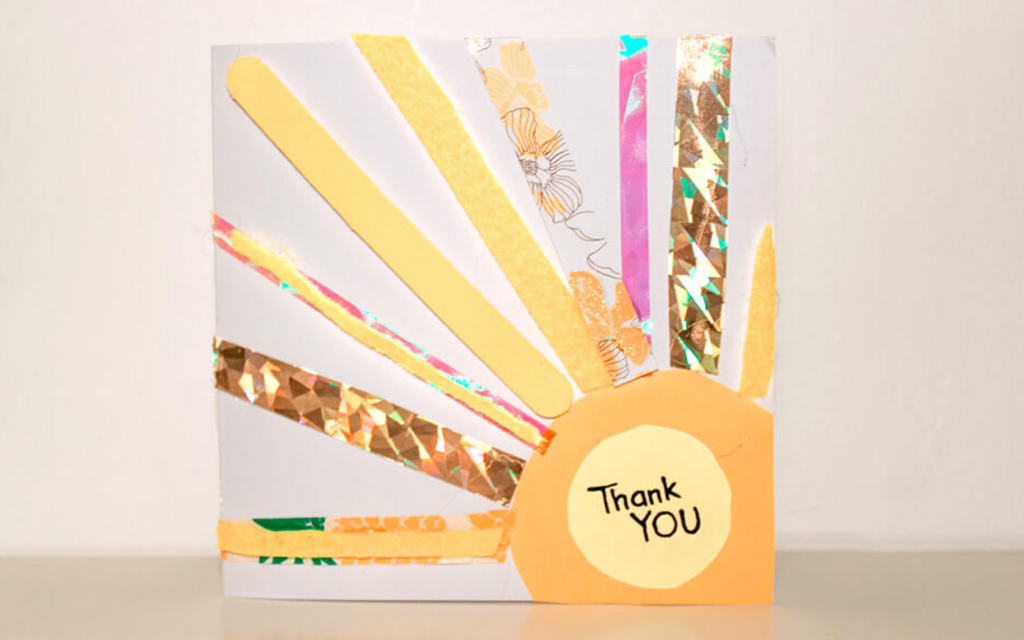
Gratitude Circle
This group activity is perfect for preschool classrooms or family settings. Sit in a circle and let each child take turns sharing one thing they are thankful for. Please encourage them to listen to each other and respond positively. You can even vary the theme by asking for things they were grateful for that day or for someone who helped them recently. It strengthens both emotional articulation and community spirit.
Emotion Match Game
Print or draw cards showing different facial expressions or emotional words like “grateful,” “happy,” “excited,” and “loved.” Ask children to match those feelings with real-life events. For example, “When did you feel thankful today?” or “What made you feel loved this morning?” This activity helps them connect gratitude to emotional awareness and recognize those feelings in themselves and others.
Appreciation Walk
Take a short walk outdoors—around the block, in a park, or on school grounds—and challenge kids to name five things they appreciate. It could be the sunshine, a friendly neighbor, or even a pretty flower. After the walk, discuss why those things made them feel thankful. This simple mindfulness practice encourages children to observe their environment and find beauty or joy in ordinary things.
Gratitude Storytime
Choose books with gratitude themes such as Bear Says Thanks, The Thankful Book, or Gratitude is My Superpower. Read aloud and pause to ask reflective questions like, “How did the character feel when they received help?” or “What could you say if someone did something kind for you?” These discussions bring the concept of thankfulness into the child’s emotional vocabulary and strengthen their ability to identify with others.
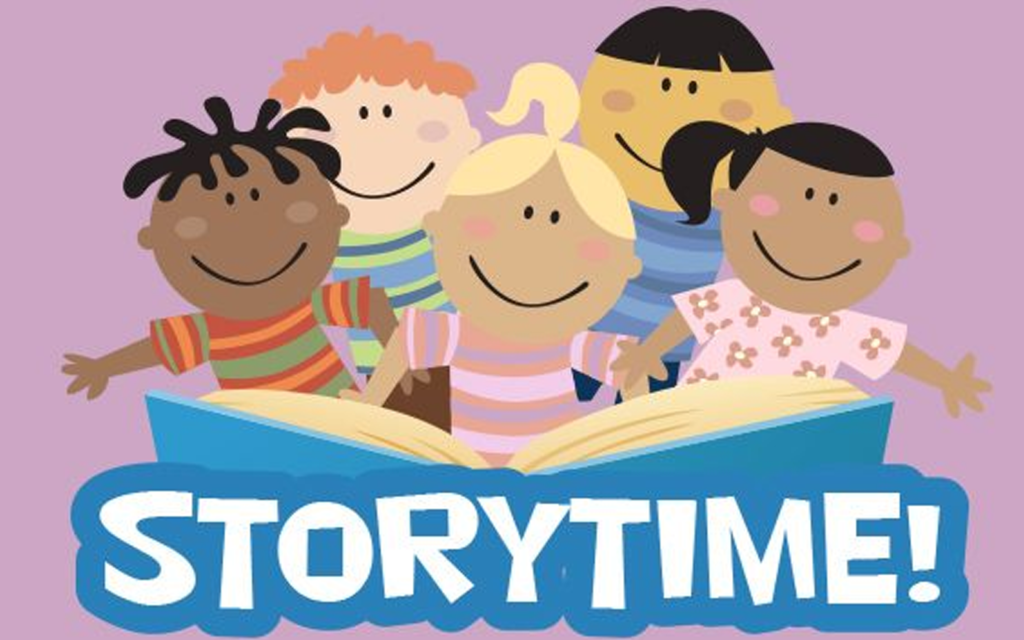
Helping Hands Chart
Design a chart where kids earn stickers or stamps for acts of helpfulness and gratitude throughout the week. This can include saying thank you without prompting, helping a sibling clean up, or noticing something someone else did for them. At the end of the week, review the chart together and talk about how those actions made others feel. This activity reinforces positive behavior and builds awareness of social responsibility.
Daily Gratitude Journals
Give each child a journal where they can write or draw something they’re thankful for every day. For younger kids who can’t write yet, parents or teachers can help them record their thoughts, or they can use stickers and pictures. Revisiting entries over time allows children to see patterns in what brings them joy and strengthens the habit of daily reflection.
Thankful Puppet Theater
Let kids create puppets and act out simple scenes where characters show gratitude, help each other, or say thank you. They can create their own stories or act out real experiences from their own lives. Through role-play, children learn to internalize social behavior and emotional understanding in a creative, memorable way.
These gratitude activities for kids are more than just lessons—they are practices that build emotional foundations. When used regularly at home or in the classroom, they help children grow into kind, reflective, and emotionally aware individuals who understand the power of appreciation in building meaningful relationships.
فصلك الدراسي المثالي على بعد نقرة واحدة!
Books for 3 to 5-Year-Olds: Teaching Gratitude to Children
“Thank You, Omu!” by Oge Mora
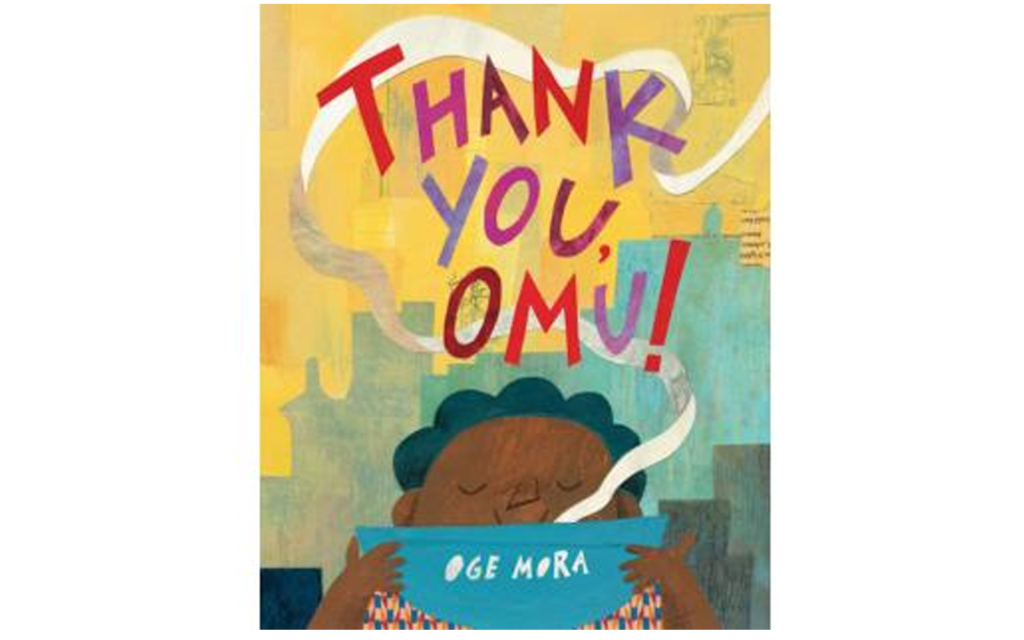
A beautiful story about generosity and community. Omu cooks a delicious stew and shares it with her neighbors. In return, they show their appreciation in the most heartfelt way. This story gently introduces the idea of giving and gratitude.
“Bear Says Thanks” by Karma Wilson & Jane Chapman
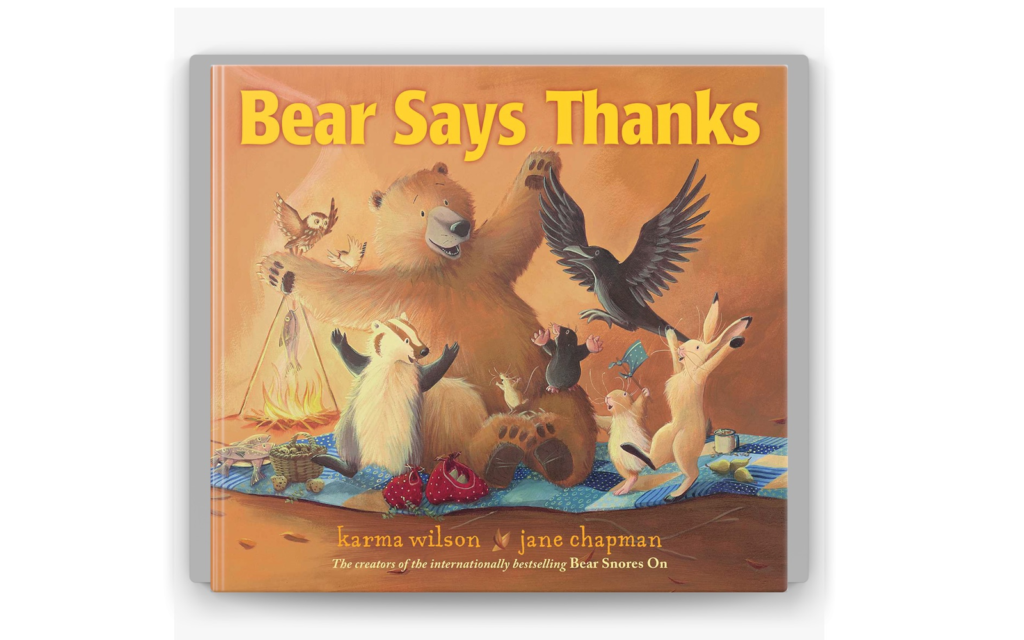
Bear wants to thank his friends for their kindness, but he has nothing to offer—until he realizes that his presence and appreciation are enough. A rhyming, simple story that teaches the value of saying “thank you” and being together.
“The Thankful Book” by Todd Parr
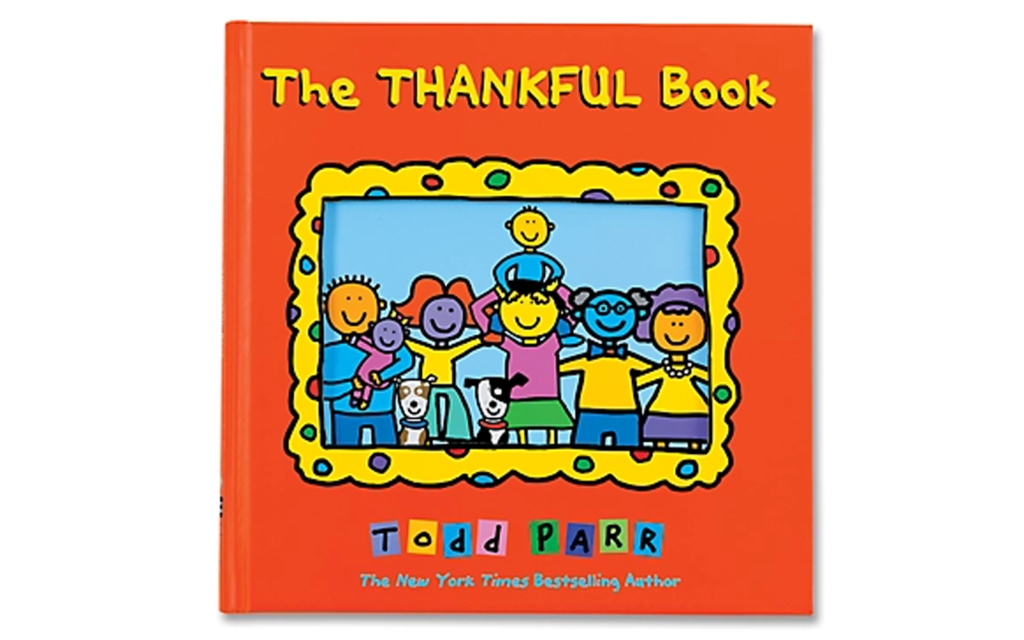
Bright, bold illustrations and simple sentences make this book ideal for preschoolers. It helps children recognize the little things in life to be grateful for—from music and friends to pets and cozy beds.
“Gratitude is My Superpower” by Alicia Ortego
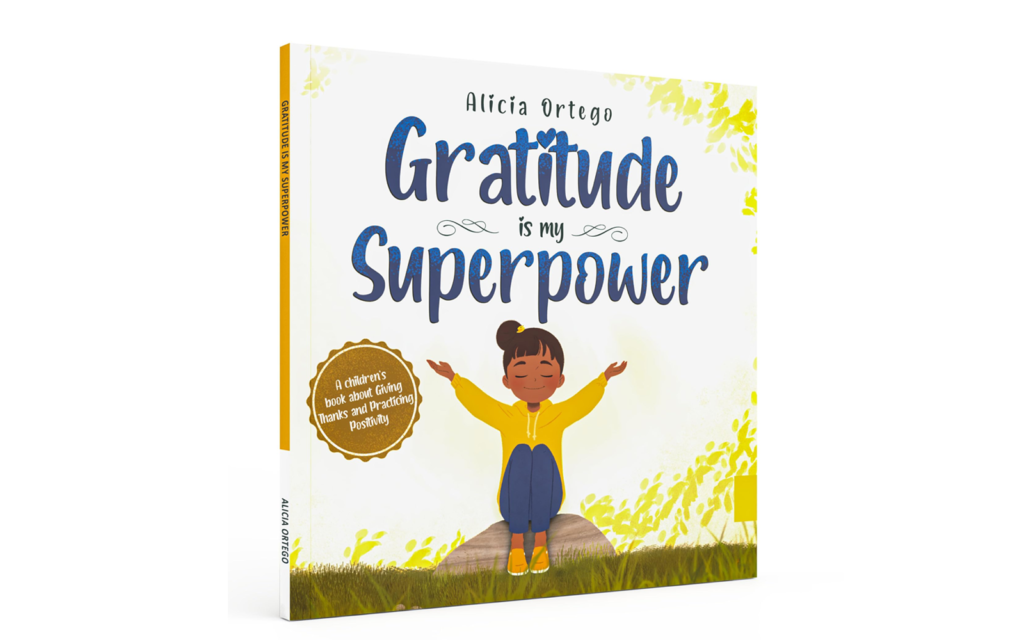
This book follows a little girl named Betsy as she discovers how gratitude changes how she feels about the world. It’s an excellent tool for teaching gratitude to children through a simple story and positive thinking exercises.
“Apple Cake: A Gratitude” by Dawn Casey
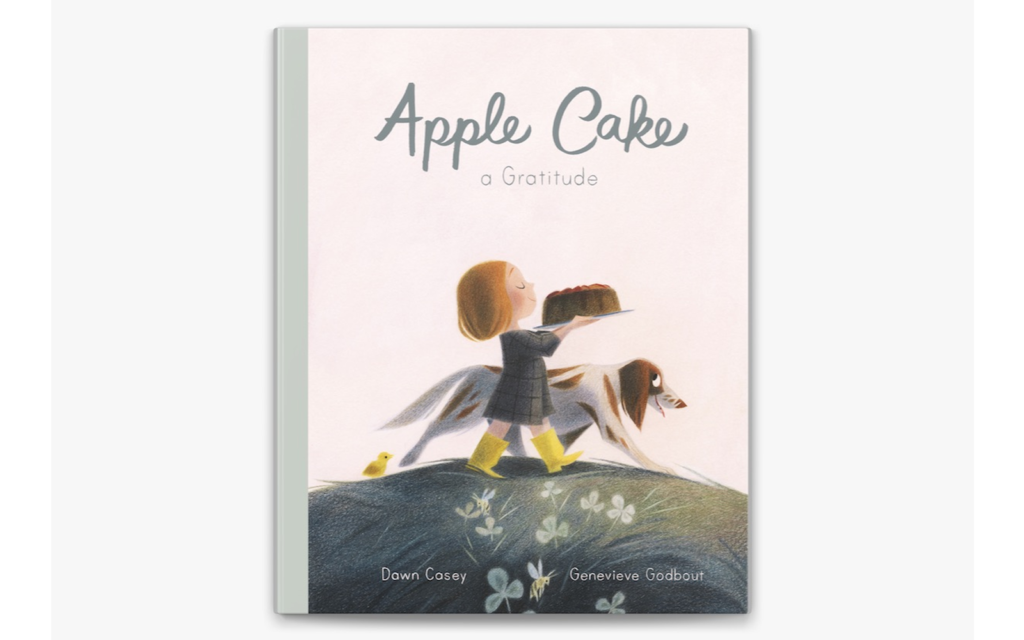
A poetic and nature-centered book that follows a child giving thanks for each ingredient in a homemade apple cake. It’s a calm and gentle way to teach appreciation for the world and the people in it.
الأسئلة الشائعة
1. At what age should I start teaching gratitude to children?
Teaching gratitude to children can begin as early as age two. While toddlers may not fully understand the concept, they can start to imitate words like “thank you.” By age three or four, children begin to understand the emotions behind gratitude. This is an ideal time to introduce simple gratitude activities that encourage empathy and appreciation.
2. How is teaching gratitude to children different in Montessori classrooms?
In Montessori classrooms, teaching gratitude to children is integrated into daily life through practical activities, grace and courtesy lessons, and community-building routines. Instead of isolated lessons, gratitude is modeled and experienced in authentic contexts, like helping a peer, caring for materials, and reflecting on kindness. This approach encourages children to internalize gratitude as part of their character, not just a social skill.
3. What are some daily habits that can help in teaching gratitude to children at home?
Simple daily routines like bedtime gratitude reflections, thank-you card crafts, or morning “grateful for” moments can be powerful. Consistency is key. When gratitude becomes part of a child’s everyday routine—just like brushing teeth—it slowly shapes their emotional mindset. The goal is to create a natural rhythm that makes appreciation a regular part of how they see the world.
4. How can I teach gratitude to children who seem entitled or unappreciative?
Teaching gratitude to children who display entitlement starts with shifting their focus from what they want to what they have. Use tools like gratitude journals, community service, and perspective-based storytelling to help them understand effort and kindness. Reinforce moments when they express genuine appreciation and avoid over-rewarding materialism. The key is emotional connection, not correction.
5. What are the emotional benefits of teaching gratitude to children?
Children who are taught gratitude tend to be more emotionally balanced, empathetic, and resilient. Gratitude helps children recognize positive experiences, value relationships, and develop a growth mindset. Over time, this supports better stress management, improved social behavior, and overall emotional intelligence.
6. Can gratitude be taught through play or creative activities?
Absolutely. Teaching gratitude to children through creative play—such as puppet shows, drawing, storytelling, or music—is both fun and effective. These activities help children connect emotionally with the concept of appreciation and make the lesson memorable. Gratitude doesn’t have to be taught with lectures—it can be explored through joyful expression.
7. How do I reinforce gratitude without forcing children to say “thank you”?
Gratitude is more meaningful when it comes from understanding rather than obligation. Instead of demanding a “thank you,” model sincere appreciation yourself and discuss why you feel thankful. Teaching gratitude to children works best when it’s reflective—help them notice how they feel when others are kind, and give them space to express thanks in their way.
خاتمة
Teaching gratitude to children is more than a matter of manners—it’s about nurturing empathy, emotional intelligence, and social awareness from the earliest years. Whether through Montessori-inspired practices, creative activities, or daily reflection, gratitude can be taught in meaningful and age-appropriate ways. From ages 2 to 7 and beyond, children benefit greatly from a structured yet loving environment where appreciation is modeled, practiced, and celebrated. When we intentionally teach gratitude to children, we’re not just building better behavior—we’re shaping compassionate, thoughtful individuals ready to connect with the world in positive and lasting ways.

